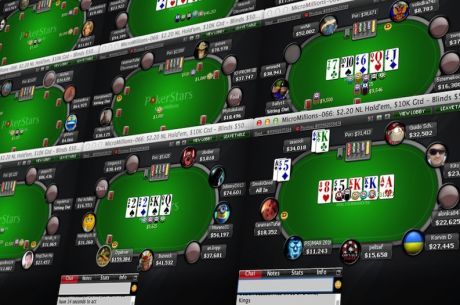All In Without a Pair: A Memorable Cash Game Hand

Last summer while at the Rio All-Suite Hotel and Casino during the World Series of Poker, I played a memorable hand in a $2/$5 no-limit hold��em cash game that illustrated several lessons from which players looking to improve their games can benefit.
I was in the cutoff. The button, to my immediate left, put on a ��Mississippi straddle�� or ��button straddle�� for $10. The rules governing a button straddle differ from casino to casino. In the Rio cash games, the action following a button straddle simply begins to the button��s left, so that the small blind can either call $8 or fold, the big blind then acts, and so on.
In this hand it folded around to two players in middle position who limped. The second limper was a loose player who had just lost a big pot to me and was stuck.
I held A?10? and raised to $60. This is unusally large for the first raise in a $2/$5 game, but with $37 in the pot before the action got to me, $60 was barely more than a pot-sized raise. Moreover, in this spot it would be nice to ��win the button�� with my raise by folding the button out, another benefit of not choosing a smaller raise size.
Only the second limper called my raise. After the rake, there was $142 in the pot, he had another $725 in his stack, and I covered him. He was ready enough to gamble that I thought he would have only folded the worst 30-40% of his limping hands (which was also a very wide range).
The flop came J?9x3?. This was an excellent flop for me, giving me the nut flush draw, an overcard, and three to a straight. My opponent checked, I bet $75, and he surprised me by immediately moving all in for $650 more. I called almost as quickly as he had bet.
You will sometimes hear advice not to call all in with a draw. It��s true that it is often better to bet all in than to call all in with a draw, and it��s also true that many draws are weak and do not justify calling a big bet.
A draw as strong as A?10? on this board, however, is different. First of all, it has excellent equity even against my opponent��s strongest hands. Even if I had gotten unlucky and been up against a set of threes, I would have had over 27% equity. Meanwhile I would have been nearly even money against a strong one-pair hand.
Secondly, this hand has the virtue of crushing other draws. Against a worse flush draw or straight draw I would have been a commanding favorite. Indeed, as it turned out my opponent showed up with K?4? and was disappointed to see that when a club came on the turn his flush was no good.
It��s not every session I put $785 in the pot in a $2/$5 game before I make a pair, but this was a time for it. I��ve already explained my basic reasoning for my plays, but here are a few more quick lessons from the hand:
Cultivate preflop discipline
I had to remind myself before the flop to raise, and not just call, with the A?10?. The hand plays well in limped pots, and I was a little worried that my opponents would make smart plays against me if I bloated the pot. Against loose limpers, however, this hand is simply too strong not to raise.
I often see even competent players make preflop decisions based on the feelings that are evoked by the thoughts of playing small or big pots. If the big pot feels better, they raise with the hands that are closer decisions. You can do better than this by thinking through your preflop decisions, continuing to raise when it��s correct even when you don��t feel lucky, and continuing to fold even when you feel like playing lots of pots.
Know the rules
Many players at the Rio don��t know that button straddles are allowed. It isn��t always a correct play, but giving yourself the last action at higher stakes when you��re on the button often merits investing the two big blinds. But you can��t make the play if you don��t know it��s allowed.
Remember that hand strength is relative
Sometimes Ax10x is what is called a ��payoff hand.�� Against a tight early-position raiser, for example, you can hit the board with it, but still often be far behind. Against two loose limpers, however, and with the benefit of position, it��s a very good hand that will dominate many weaker aces and tens.
In other words, that the question ��Does Ax10x have implied odds or reverse implied odds?�� is incomplete if the situation is not further specified. It will play very well, and dominate many opponents, in situations like the one I played �� especially when it is suited. In others, it will cause a lot of trouble.
Be sure to check out Nate and Andrew Brokos on the Thinking Poker podcast, and for more from Nate visit his blog at natemeyvis.com.
Get all the latest PokerNews updates on your social media outlets. Follow us on Twitter and find us on both Facebook and Google+!








